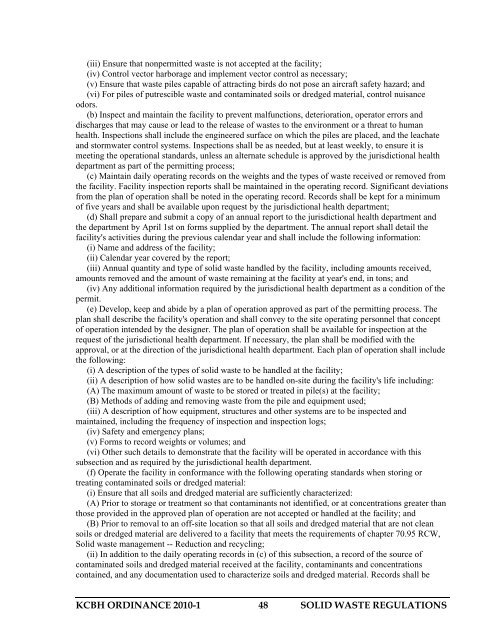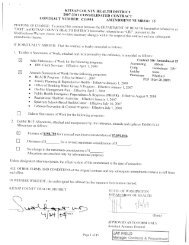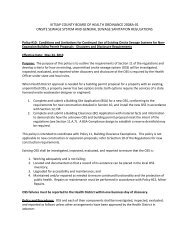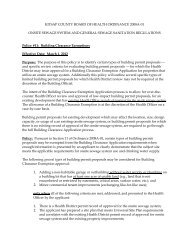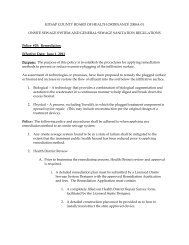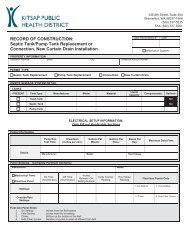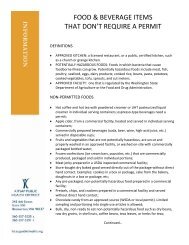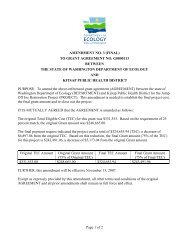SOLID WASTE REGULATIONS - Kitsap Public Health District
SOLID WASTE REGULATIONS - Kitsap Public Health District
SOLID WASTE REGULATIONS - Kitsap Public Health District
Create successful ePaper yourself
Turn your PDF publications into a flip-book with our unique Google optimized e-Paper software.
(iii) Ensure that nonpermitted waste is not accepted at the facility;<br />
(iv) Control vector harborage and implement vector control as necessary;<br />
(v) Ensure that waste piles capable of attracting birds do not pose an aircraft safety hazard; and<br />
(vi) For piles of putrescible waste and contaminated soils or dredged material, control nuisance<br />
odors.<br />
(b) Inspect and maintain the facility to prevent malfunctions, deterioration, operator errors and<br />
discharges that may cause or lead to the release of wastes to the environment or a threat to human<br />
health. Inspections shall include the engineered surface on which the piles are placed, and the leachate<br />
and stormwater control systems. Inspections shall be as needed, but at least weekly, to ensure it is<br />
meeting the operational standards, unless an alternate schedule is approved by the jurisdictional health<br />
department as part of the permitting process;<br />
(c) Maintain daily operating records on the weights and the types of waste received or removed from<br />
the facility. Facility inspection reports shall be maintained in the operating record. Significant deviations<br />
from the plan of operation shall be noted in the operating record. Records shall be kept for a minimum<br />
of five years and shall be available upon request by the jurisdictional health department;<br />
(d) Shall prepare and submit a copy of an annual report to the jurisdictional health department and<br />
the department by April 1st on forms supplied by the department. The annual report shall detail the<br />
facility's activities during the previous calendar year and shall include the following information:<br />
(i) Name and address of the facility;<br />
(ii) Calendar year covered by the report;<br />
(iii) Annual quantity and type of solid waste handled by the facility, including amounts received,<br />
amounts removed and the amount of waste remaining at the facility at year's end, in tons; and<br />
(iv) Any additional information required by the jurisdictional health department as a condition of the<br />
permit.<br />
(e) Develop, keep and abide by a plan of operation approved as part of the permitting process. The<br />
plan shall describe the facility's operation and shall convey to the site operating personnel that concept<br />
of operation intended by the designer. The plan of operation shall be available for inspection at the<br />
request of the jurisdictional health department. If necessary, the plan shall be modified with the<br />
approval, or at the direction of the jurisdictional health department. Each plan of operation shall include<br />
the following:<br />
(i) A description of the types of solid waste to be handled at the facility;<br />
(ii) A description of how solid wastes are to be handled on-site during the facility's life including:<br />
(A) The maximum amount of waste to be stored or treated in pile(s) at the facility;<br />
(B) Methods of adding and removing waste from the pile and equipment used;<br />
(iii) A description of how equipment, structures and other systems are to be inspected and<br />
maintained, including the frequency of inspection and inspection logs;<br />
(iv) Safety and emergency plans;<br />
(v) Forms to record weights or volumes; and<br />
(vi) Other such details to demonstrate that the facility will be operated in accordance with this<br />
subsection and as required by the jurisdictional health department.<br />
(f) Operate the facility in conformance with the following operating standards when storing or<br />
treating contaminated soils or dredged material:<br />
(i) Ensure that all soils and dredged material are sufficiently characterized:<br />
(A) Prior to storage or treatment so that contaminants not identified, or at concentrations greater than<br />
those provided in the approved plan of operation are not accepted or handled at the facility; and<br />
(B) Prior to removal to an off-site location so that all soils and dredged material that are not clean<br />
soils or dredged material are delivered to a facility that meets the requirements of chapter 70.95 RCW,<br />
Solid waste management -- Reduction and recycling;<br />
(ii) In addition to the daily operating records in (c) of this subsection, a record of the source of<br />
contaminated soils and dredged material received at the facility, contaminants and concentrations<br />
contained, and any documentation used to characterize soils and dredged material. Records shall be<br />
KCBH ORDINANCE 2010-1 48 <strong>SOLID</strong> <strong>WASTE</strong> <strong>REGULATIONS</strong>


